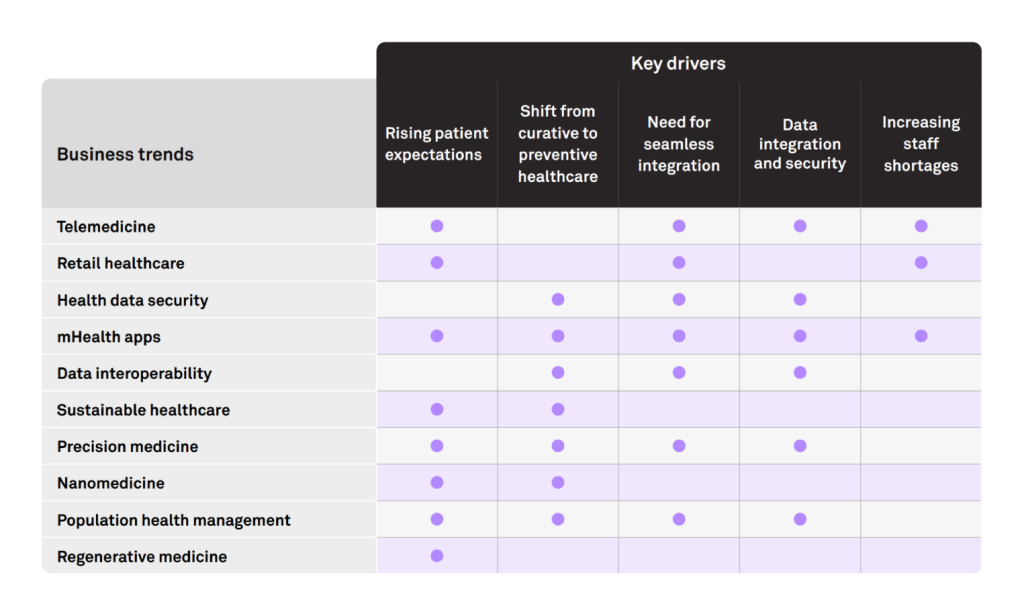How AI will impact your business
Shikhar Ghosh, Professor, Harvard
Watch Now
17:41 Minutes The average reading duration of this insightful report.

Healthcare transforms with a focus on accessibility, prioritizing IT, the global market is projected at USD 975 billion by 2027. AI and machine learning, expected in 90% of US hospitals by 2025, streamline chronic condition diagnoses. Emerging technologies drive change, influencing preventive and home care in the healthcare landscape.
Explore a sneak peek of the full content
Healthcare IT is a top priority for providers. Nearly 80% of healthcare providers consider it one of their top 5 strategic priorities, with investments in software including revenue cycle management, security and privacy, patient intake/flow, clinical systems, and telehealth. AI, ML, and IoMT are rapidly developing and expected to be used in 90% of US hospitals by 2025. The global mHealth apps market is growing, primarily driven by the adoption of fitness and medical apps. Technology can improve patient care, reduce medical errors, and expand hospital boundaries. However, data interoperability and regulations are necessary, and patient engagement is crucial for a better healthcare system. Download Complete Research
Empowering customers through GenAI

Credits
Lead Authors@lab45: Anju James
Contributing Authors@lab45: Hussain S Nayak

13:03 Minutes The average duration of a captivating reports.

Reusable rockets & satellite miniaturization collaboratively are democratizing access to space. Fuelling innovation across multiple domains and fostering a future where space is accessible to enterprises, individuals, and nations alike.
The section delves into the historical roots of the space race between the United States and the Soviet Union, highlighting its profound impact on technological advancements. It explores how the competition between these superpowers catalyzed innovations that have become essential in various industries, including telecommunications, healthcare, and more. The section also discusses how the end of the space race didn't mean the end of innovation but rather heralded a new era of technological advancements that continue to shape our world today.
This section focuses on the economic revolution brought about by the introduction of reusable rockets. It discusses how companies like SpaceX have drastically reduced the cost of space exploration by developing rockets that can be landed and reused. This has made space more accessible to not just governments but also private entities and educational institutions, thereby democratizing space exploration. Download Complete Research

The section provides an in-depth look at SpaceX's Falcon 9 rocket, one of the most iconic reusable rockets in the industry. It discusses its design, capabilities, and the groundbreaking technology that allows it to be reused, making space travel more economical and sustainable. The Falcon 9 serves as a case study for the potential future of cost-effective space exploration.
This section explores the trend of miniaturization in satellite technology, focusing on the development of CubeSats. These small, modular satellites have opened up new avenues for space exploration and commercial applications. Their smaller size and modular design make them more cost-effective and accessible, allowing for a wider range of applications and participants in space technology. Download Complete Research
The section discusses how CubeSats are revolutionizing agriculture by providing high-resolution imagery of farmland. This technology enables more efficient and effective resource allocation, transforming traditional farming methods. CubeSats are making precision farming more accessible, allowing for optimized use of water, fertilizers, and workforce, thereby making farming more sustainable and cost-effective.

This section delves into the additional innovations that CubeSats have enabled, beyond their initial applications. It discusses how these small satellites serve as testbeds for new technologies and scientific research, from studying Earth's atmosphere to testing new materials and communication technologies. CubeSats are paving the way for future advancements in space technology. Download Complete Research
The section explores the emerging business models in the space industry, particularly focusing on the 'As-a-Service' models. It discusses how these models are making space technology more affordable and accessible, from Data-as-a-Service to Mission-as-a-Service. These new business models have the potential to further democratize space technology, making it accessible to a broader range of participants.
Credits
Authors@lab45: Abhigyan Malik
Key contributors: Ariel Zajdband, Planet

22:18 Minutes The average duration of a captivating reports.

This document navigates current airport challenges and presents advanced technology as the key to solutions. It offers profound insights into the future of global aviation, encompassing passenger management, sustainability, and technological integration.
The not-so-smart airports of the present face numerous challenges. Operations suffer from capacity issues, flight delays, and inefficiencies. Passengers endure long queues, baggage mishaps, and limited amenities. Root causes include aging infrastructure, rising air travel demands, and heightened expectations. Solutions must address sustainability, accessibility, cargo flow, baggage handling, workforce shortages, and facility limitations.
The global travel shift: Current industry and market trends reveal airports' adoption of new technology and operational strategies to tackle challenges. Emerging trends include enhanced passenger experiences, optimized capacity, safety measures, regulatory compliance, cargo logistics, and sustainability efforts. These initiatives reflect a trifecta of technological innovation, evolving customer expectations, and sustainability goals. Download Complete Research
Cutting-edge technology is revolutionizing airport operations, addressing core challenges. From AI-based gate allocation to IoT-enabled passenger flow monitoring, these innovations enhance efficiency, sustainability, and safety. Adoption levels vary, but promise a smarter future for airports.

The aviation sector faces sustainability challenges despite significant growth projections. Airports employ millions but also contribute to emissions, noise pollution, and land use issues. Innovative solutions are crucial to mitigate environmental impacts. New technologies offer hope, with initiatives focusing on energy efficiency, waste management, water conservation, carbon emissions reduction, sustainable construction, stakeholder engagement, and sustainable transportation. Adopting a "smart airport" mindset and leveraging advanced technologies are essential for sustainable development. Download Complete Research
Smart airport innovations offer incremental improvements, enhancing every aspect of the customer journey. From baggage tracking to disruption management, each innovation contributes to a vastly improved airport experience. These subtle enhancements, when integrated into a comprehensive system, create truly evolved airports. While current developments may seem marginal, they lay the groundwork for future radical transformations. Foundational changes in data and cloud technologies, along with private networks and digital twins, are revolutionizing airport operations. Innovations in transportation, such as urban air mobility and self-driving passenger vehicles, aim to streamline end-to-end customer transportation. With a growing focus on sustainability and continuous innovation, airports are poised for significant advancements in the coming years.
Future airports represent the culmination of incremental improvements, resulting in a transformative rethinking of airport design, operation, and customer experience. Redefining each step of the passenger journey from first principles can revolutionize airport travel. From travel to the airport to reaching the final destination, autonomous vehicles offer seamless transportation, reducing stress and travel time. Check-in and security procedures can be streamlined through biometrics and digital identity, eliminating the need for documents and minimizing delays. Optimized luggage handling and security checks ensure efficiency and convenience. Boarding processes can be expedited through automated sorting and biometric verification, enhancing overall travel experience. Additionally, autonomous vehicles can facilitate efficient flight transfers, reducing stress for passengers during layovers. With innovative technologies and redesign of airport processes, future airports promise a more seamless and enjoyable travel experience for passengers worldwide. Download Complete Research
Credits
Lead Authors@lab45: Ankit Pandey
This is your invitation to become an integral part of our Think Tank community. Co-create with us to bring diverse perspectives and enrich our pool of collective wisdom. Your insights could be the spark that ignites transformative conversations.
Learn MoreKey Speakers
Thank you for subscribing!!!
